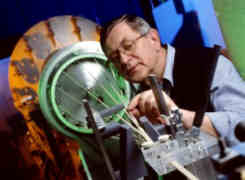Tomorrow’s High-Temperature Superconducting Cables

Developers have succeeded in "stranding" HTS wires into cables. <br>
Future generations of electric trains may use considerably less power than they do today thanks to the development of the first high temperature superconducting (HTS) cable. To produce the cable, Scientists at Siemens Corporate Technology in Erlangen, Germany started out with micron-sized particles of a brittle ceramic material. The particles were then embedded in a silver alloy. Through repeated rolling stages and annealing, the material was turned into ribbon-shaped wires. To make a cable from such wires, the developers employed a technology used in manufacturing transformers, whereby several HTS strip conductors are “stranded” into a flat cable. This method opens the door to large-scale production of flexible, high capacity / low loss cables. Altogether, engineers managed to strand 13 wires into a 400 meter-long cable. They then installed the cable in a model HTS transformer with an output of one megavolt-ampere (MVA) – enough to drive a normal passenger train. The new technology could reduce the weight of such a transformer by a third without any reduction in output. In addition, it would have an efficiency of over 98 percent compared to the “mere” 90 percent of a conventional transformer.
Media Contact
All latest news from the category: Process Engineering
This special field revolves around processes for modifying material properties (milling, cooling), composition (filtration, distillation) and type (oxidation, hydration).
Valuable information is available on a broad range of technologies including material separation, laser processes, measuring techniques and robot engineering in addition to testing methods and coating and materials analysis processes.
Newest articles

Properties of new materials for microchips
… can now be measured well. Reseachers of Delft University of Technology demonstrated measuring performance properties of ultrathin silicon membranes. Making ever smaller and more powerful chips requires new ultrathin…

Floating solar’s potential
… to support sustainable development by addressing climate, water, and energy goals holistically. A new study published this week in Nature Energy raises the potential for floating solar photovoltaics (FPV)…

Skyrmions move at record speeds
… a step towards the computing of the future. An international research team led by scientists from the CNRS1 has discovered that the magnetic nanobubbles2 known as skyrmions can be…





















